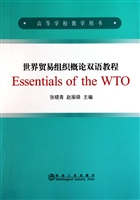世界贸易组织概论双语教程(高等学校教学用书)
作 者:张晓青//赵振铎
出 版 社:冶金工业出版社
丛 书:高等学校教学用书
出版时间:2010年08月
定 价:20.00
I S B N :9787502453213
所属分类: 教育学习 > 教材 > 研究生/本科/专科教材 人文社科 > 经济 > 经济实务 > 贸易
标 签:贸易经济 经 济 财经管理
本书分5章介绍世界贸易组织(WTO)的产生及运行机制、WTO的基本原则、WTO的有关协议、WTO贸易政策审议机制和争端解决机制、发展中国家在世贸组织中的状况,书后附有WTO成员国名单、WTO的缩略语和术语。本书内容适合48学时的授课,可作为经贸专业的本科生、研究生的教材使用,也可供经济界学者参考阅读。
Chapter 1 The Establishment and Operating System of the WTO
1.1 The Establishment of the WTO
1.1.1 The GATF years: from Havana to Marrakesh
1.1.2 The Uruguay Round
1.1.3 The post-Uruguay Round built-in agenda
1.2 The Status, Purpose, Objectives and Functions of the WTO
1.2.1 Status of the WTO
1.2.2 The purpose of the WTO
1.2.3 The objectives of the WTO
1.2.4 The functions of the WTO
1.2.5 Differences between GATF and WTO
1.3 Scope of the WTO
1.4 Structure of the WTO
1.4.1 The Ministerial Conference
1.4.2 The General Council iri three guises
1.4.3 Councils for each broad area of trade, and more
1.4.4 Committees
1.4.5 Plurilateral Committee
1.4.6 The Secretariat and director-general
1.5 Decision-making of the WTO
1.5.1 Decisions taken by consensus
1.5.2 Levels of authority
1.6 Membership of the WTO
1.6.1 Original membership
1.6.2 Accession to the WTO
1.6.3 How to join the WTO: the accession process
1.6.4 Withdrawal from the WTO
1.7 Relationship with Other Main Organizations and Regionalism
1.7.1 Summary on other organizations
1.7.2 Relationship with regionalism
Questions
Notes
Chapter 2 Principles of the WTO
2.1 Trade without Discrimination
2.1.1 Most- favoured- nation (MFN)
2.1.2 National treatment: treating foreigners and locals equally
2.2 Freer Trade: Gradually, through Negotiation
2.2.1 Trade barriers
2.2.2 The result of negotiations
2.3 Predictability: through Binding and Transparency
2.3.1 Purpose of predictability
2.3.2 Predictability through binding
2.3.3 Predictability through transparency
2.4 Promoting Fair Competition
2.5 Encouraging Development and Economic Reform
2.5.1 Contribution to developing countries in the WTO
2.5.2 Commitment fulfilled by developing countries
2.5.3 Measures to encourage development and economic reform
Questions
Notes
Chapter 3 The Agreements of the WTO
3.1 Agreements for Trade in Goods
3.1.1 Tariffs: more bindings and closer to zero
3.1.2 Agriculture: fairer markets for farmers
3.1.3 Standards and safety
3.1.4 Textiles: back in the mainstream
3.1.5 Anti-dumping, subsidies, safeguards: contingencies, etc
3.1.6 Non-tariff barriers : red tape, etc
3.1.7 Plurilaterals: of minority interest
3.2 Agreement for Trade in Service
3.2.1 The background for GATS
3.2.2 Main content of GATS
3.2.3 General obligations and disciplines
3.2.4 The annexes: services are not all the same
3.3 Agreement for Trade-related Aspects of Intellectual Property Rights
3.3.1 Scope of intellectual property
3.3.2 International protection of intellectual property and TRIPS
3.3.3 Summary on TRIPS
Questions
Notes
Chapter 4 The Policy Review and Settling Dispute
4.1 Trade Policy Review
4.1.1 Ways to keep trade policies transparent
4.1.2 Trade Policy Review Body
4.2 Settling Dispute
4.2.1 Summary on dispute settlement mechanism
4.2.2 Scope of jurisdiction of DSM
4.2.3 WTO bodies involved in the dispute settlement process
Questions
Notes
Chapter 5 Developing Countries
5.1 Overview
5.1.1 In the agreements: more time, better terms
5.1.2 Legal assistance: a secretariat service
5.1.3 Least-developed countries: special focus
5.1.4 A "maison"in Geneva: being present is important, but not easy for all
5.2 Committees
5.2.1 Trade and Development Committee
5.2.2 Subcommittee on Least-Developed Countries
5.2.3 The Doha agenda committees
5.3 WTO Technical Cooperation
5.3.1 Mission, objective and subjects
5.3.2 Training, seminars and workshops
5.4 Some Issues Raised
5.4.1 Participation in the system: opportunities and concerns
5.4.2 Erosion of preferences
5.4.3 The ability to adapt: the supply-side
Questions
Notes
References
Appendix
Appendix 1 Current WTO Members
Appendix 2 Abbreviations
Appendix 3 Glossary
Appendix 4 Reading Materials
